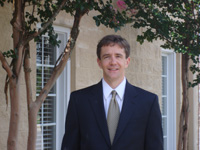Editorial
Front Page - Friday, December 10, 2010
Using technology, Dr. John Hoover relieves fear of endodontics
Erica Tuggle
 Dr. John P. Hoover has been providing compassionate care and professional service through the use of the latest technology at the Center for Endodontics for over 13 years. Endodontics concentrate on repairing the interior portion of teeth and include procedures for root canal therapy, microscopic endodontics, endodontic retreatment and surgery, cracked teeth and traumatic injuries.
- Photo provided
Dr. John P. Hoover has been providing compassionate care and professional service through the use of the latest technology at the Center for Endodontics for over 13 years. Endodontics concentrate on repairing the interior portion of teeth and include procedures for root canal therapy, microscopic endodontics, endodontic retreatment and surgery, cracked teeth and traumatic injuries.
- Photo provided
Just hearing the words “root canal” make people visibly wince as they imagine this process that over 14 million patients undergo each year and carries with it a phobia that has many wary of stepping up to the dentist’s chair at all.
Yet, root canals are necessary to save a tooth from extraction when the pulp inside the tooth becomes inflamed or infected, which is caused by trauma to the tooth, deep decay, cracks or repeated dental procedures. ?If pulp inflammation or infection is left untreated it can cause pain or can lead to abscess.
Dr. John P. Hoover, D.D.S, says technology has improved so much that with modern and competent treatment endodontic procedures can be pain free.
He says, “Many patients say their root canal was as easy on them as a filling. It used to take two to three visits for the tooth to be completed. Today, many teeth can be completed in just one visit.”
These welcome words of relief from Hoover are exactly what you want to hear when you visit his Shallowford Road office at the Center for Endodontics, where he has been performing procedures on the inner structure of teeth for over 13 years.
Hoover grew up in Chattanooga, attending Boyd-Buchanan High School, UTC and then UT Memphis Health Science Center for Dental School. He then completed his specialty residency at Boston University Goldman School of Dental Medicine. He says he became interested in dentistry at seven years of age after a visit to the dentist for a restoration of a fractured tooth. Later, he became more impressed with the inner workings of teeth by the fast results of his orthodontic treatment.
In dental school, he found endodontics interesting and liked its challenging nature. He really began to enjoy endodontics when one of his instructors took particular interest to mentor him and teach him a lot of the need-to-know information for dentists in this field. During his two-year specialty residency at Boston University, he studied under Dr. Herb Schilder, who was world renowned for his pioneering work in endodontics. Schilder developed the Warm Vertical Condensation Technique, also known as the “Schilder Technique.” This technique may also sound familiar if you have seen the Disney movie, “Finding Nemo,” which the dentist in the movie mentions.
Endodontic treatments like the Schilder Technique and root canal treatment consists of removal of the pulp or nerve tissue from the canals located inside the roots, Hoover says. The canals are cleaned and shaped and then filled with a rubber-like substance called gutta percha.
The Schilder Technique in particular ensures that the fill is a high quality three-dimensional fill of the root canal system, and is the only technique Hoover uses in his office. Endodontics procedures performed at Hoover’s Center for Endodontics include root canal therapy, microscopic endodontics, endodontic retreatment and surgery, cracked teeth and traumatic injuries.
As part of these services, Hoover and his staff sometimes use a 3D imaging system called Kodak 9000. This device is a high-resolution Cone Beam Computer Tomography system, which means that it makes a 3-D image that can be useful in a diagnosis.
The Center for Endodontics is the first root canal specialty practice in Chattanooga and only the second one in the state of Tennessee to offer this newest generation of 3D dental imaging technology.
The system within this device delivers unprecedented detail and accuracy for the most complex dental diagnostics, such as root canal pathologies, root fractures, implant placement and examination of oral pathologies. This technology also provides 3D imaging faster and with significantly less radiation than traditional scans.
Hoover says he tends to see many young patients with multiple cavities. This happens when patient’s forget to brush before bed, and is even worse if the patient drinks a soda before bed and the sugar is allowed to sit on teeth all night, he says.
“When patients brush more, they tend to have healthier teeth requiring less restorations,” Hoover says as a recommendation to the community on dental care.
Besides spending time at his Ooltewah home with his wife, Darlot, and their three children, Hoover’s hobbies are mountain biking, road biking and snow skiing.
“Biking is a great outlet and keeps me healthy,” he says. “I participate in cross-country mountain bike races all over the South. I recently won the South Eastern Regional Championship Series and the Tennessee Bicycle Racing Association Series in the Expert 40+ Class.”
Hoover and the Center for Endodontics will continue to use their skills in order to provide compassionate care and make that trip to the dentist’s chair a little easier to sink your
teeth into.
|
|